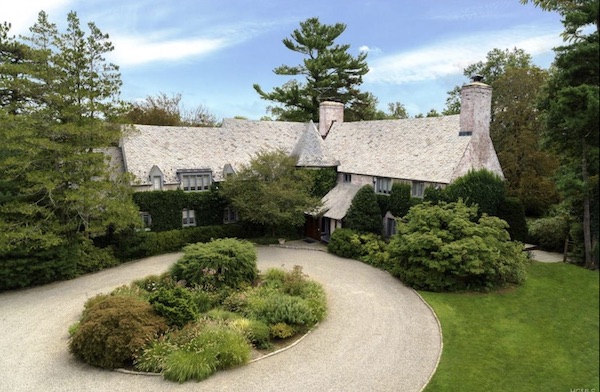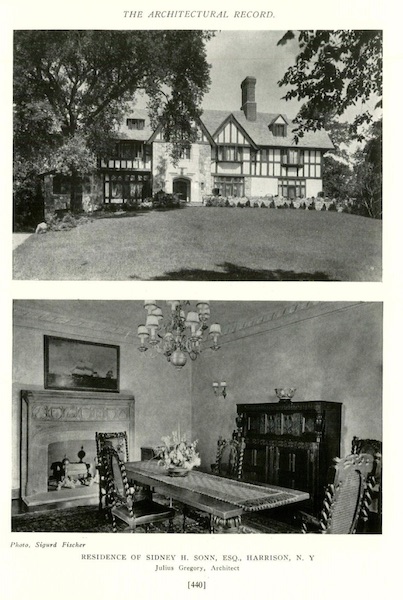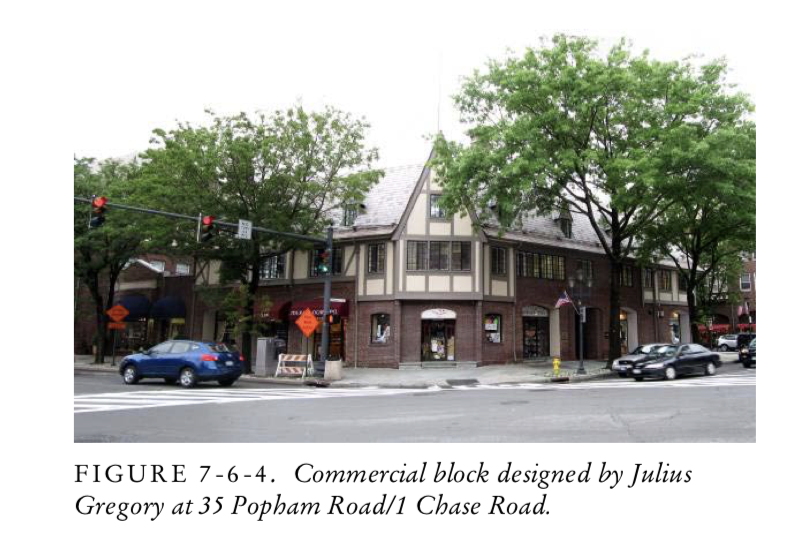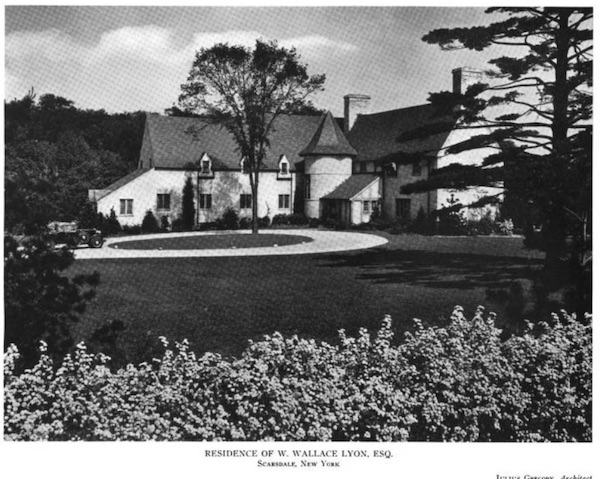Application Filed to Raze Iconic Home at 11 Dolma Road
- Category: The Goods
- Published: Monday, 15 June 2020 20:11
- Joanne Wallenstein
 The young buyers of an iconic home at 11 Dolma Road in Scarsdale have filed an application to raze the house, pool and pool house on the 3.26 acre property. Sarah and Steven Binetter purchased the home in November 2019 for $7.8 million along with an adjacent 1.6 acre property at 100 Mamaroneck Road from Daniel and Jane Och. The main house is 8,391 square feet with 6 bedrooms and 6.5 baths. It was built in 1928 and designed by noted architect Julius Gregory who was also a Scarsdale resident.
The young buyers of an iconic home at 11 Dolma Road in Scarsdale have filed an application to raze the house, pool and pool house on the 3.26 acre property. Sarah and Steven Binetter purchased the home in November 2019 for $7.8 million along with an adjacent 1.6 acre property at 100 Mamaroneck Road from Daniel and Jane Och. The main house is 8,391 square feet with 6 bedrooms and 6.5 baths. It was built in 1928 and designed by noted architect Julius Gregory who was also a Scarsdale resident.
The applicants retained White Plains law firm Cuddy and Feder to show why the house lacks merit for preservation. Cuddy and Feder in turn retained senior architectural historian, Emily T. Cooperman from Paulus, Sokolowski and Sartor, LLC to provide architectural background on the house and the architect and demonstrate why the applicants should be given the go ahead to take it down.

As background, in 2012, the Village of Scarsdale retained cultural historian Andrew Dolkhart and architects Li-Saltzman to produce a Reconnaissance Level Cultural Resource Survey of homes and landmarks in the Village. The comprehensive report recommends both individual homes that warrant preservation as well as neighborhoods – or areas – that contain groups of historic homes. The house at 11 Dolma Road was noted individually as a part of the Dolma Road study area which was singled out for its historic homes.
About Dolma Road, the study says the following, “Dolma Road, running from Murray Hill Road to Birchall Road, is a short street lined with exclusive houses on large lots, most erected between 1926 and 1929 (one dates from 1935), primarily for wealthy businessmen and their families (Figure 7-10-1). Dolma Road was largely a project of Walter J. Collet, the Scarsdale builder who was responsible for the construction of many substantial houses in the village. Collet claimed that he chose the name Dolma in reference to a mountain range in Bengal, India; just why he made this choice remains a mystery.”
 An article in the Architectural Record about a home Gregory designed in Harrison.Turning to the house at 11 Dolma Road, the report says, “The talented architect Julius Gregory, whose work can be seen in other areas of Scarsdale (including his own house), designed a huge French farmhouse at No. 11, one of the finest houses of the type in Scarsdale (Figure 7-10-11). The L-shaped brick house has a polygonal corner tower and an entrance set beneath a shed hood, a sophisticated rendition of vernacular rural French design.”
An article in the Architectural Record about a home Gregory designed in Harrison.Turning to the house at 11 Dolma Road, the report says, “The talented architect Julius Gregory, whose work can be seen in other areas of Scarsdale (including his own house), designed a huge French farmhouse at No. 11, one of the finest houses of the type in Scarsdale (Figure 7-10-11). The L-shaped brick house has a polygonal corner tower and an entrance set beneath a shed hood, a sophisticated rendition of vernacular rural French design.”
The report says Gregory was a “specialist in suburban homes, and among the most talented architects in the United States, designing this type of house for the upper middle class.”
According to Scarsdale Village Code, in order to save the house, the Committee for Historic Preservation has to rule that it meets one of the following five criteria:
(1) That the building is associated with events that have made a significant contribution to broad patterns of Village, regional, state or national history; or
(2) That the building is associated with the life of a person or persons of historical significance; or
(3) That the building is the work of a master; or
(4) That the building embodies the distinctive characteristics of a type, period or method of construction that possess high artistic value; or
(5) That the building has yielded or may be likely to yield information important in prehistory or history.
So, the decision might depend on whether or not Julius Gregory can be considered a master.
In the reconnaissance report, cultural historian Andrew Dolkhart has much to say about Julius Gregory, the architect of the home.
Discussing English Cottage style homes the report says, “In their picturesque massing, with steep roof slopes, gables, and dormers, and in their use of such features and slate roofs, casement windows, and tall chimneys, English Cottages resemble their Tudor Revival cousins; some even have small amounts of half timbering. But these buildings tend to have less decorated facades, relying for effect largely on the use of wide expanses of stucco. Architect Julius Gregory, a resident of Scarsdale and major proponent of the English Cottage style, noted in the magazine Architectural Forum that these houses constitute “one of the most interesting and picturesque forms of our domestic architecture. When carried out in the spirit of the old work and placed amid a proper setting, no other type of architecture can equal it in its quality of charm and what we may call ‘livableness.’
…. Julius Gregory, among the leading architects of traditional houses, worked throughout the metropolitan area, but designed several of his finest buildings in Scarsdale. He also lived in the community, in a medieval French style house at 3 Church Lane.
He also notes that Gregory designed 1 Chase Road in downtown Scarsdale. “The Scarsdale  Improvement Corporation established Tudor as the style for the Downtown and almost every building to follow was designed in this style. In 1926, Julius Gregory, the architect responsible for some of Scarsdale’s finest houses, designed the two-story Tudor Revival style commercial block at 35 Popham Road/1 Chase Road (Figure 7-6-4).”
Improvement Corporation established Tudor as the style for the Downtown and almost every building to follow was designed in this style. In 1926, Julius Gregory, the architect responsible for some of Scarsdale’s finest houses, designed the two-story Tudor Revival style commercial block at 35 Popham Road/1 Chase Road (Figure 7-6-4).”
In addition to his work in Scarsdale, Gregory was an active residential architect in the Bronx and Westchester. He designed 42 homes in the Fieldston historic district in Riverdale along with W. Stanwood Phillips and Dwight James Baum. Many of those historic homes remain today in the area that was landmarked as a historic district in 2003.
He also built in Edgemont, where a listing for 19 Cotswold Way said, “Designed in 1928 by Julius Gregory, the University of California-schooled Sacramento native best known for his commissions in Scarsdale and Riverdale's tony Fieldston enclave, this magnificent Tudor is truly in a league of its own. Dubbed Dunmovin, the elegantly English residence was completed in 1928 for Matthew S. Eylar, marketing master for what would ultimately become the Underwood-Sunstrand typewriter empire. One would be challenged to find any feature the home that doesn't strike awe. Every block of its robust masonry was sourced on-site. Some was salvaged from an old farmhouse that stood on the property, while the bulk is composed of the very granite blasted to lay the manor's foundation. Restored leaded glass windows, terracotta and antique limestone flooring and a Ludowici tile roof.”
In order to decide whether or not Gregory is a master, the committee might also consider references to Gregory’s work in publications of the day, of which there are many:
Here are just a few:
Gregory is quoted in “The American Architect and Architecture Review, in Volume 26, published in 1924.
In 1927, the residence of Sidney J. Sonn, esq. in Harrison, designed by Gregory is included in the Architectural Record.
Julius Gregory, “On the Charm and Character of the English Cottage,” was published in Architectural Forum 42 in March 1926. 147.
Another study, “The Country House, an Analysis of the Architect’s Method of Approach” published in the November 1927 Architectural Record includes homes designed by Gregory along with a home for C.E. Chamber in Riverdale in a 1921 issue of the Architectural Record.
However, in their report, the attorneys from Cuddy and Feder deny that Gregory was a master. It notes that his 1920 application for membership in the American Institute of Architects and a 1935 application for election to the American Institute of Architects College of Fellows were rejected. They say, “details of his architectural training are scarce.”
They diminish the importance of his publications, denying that they are architectural journals. The lawyers say, “many of these publications appear in popular homemaking periodicals, which is unsurprising given that his wife was a freelance magazine illustrator.”
Also since Gregory was well known for English Cottage style homes and Andrew Dolkhart called 11 Dolma a “French farmhouse” in the reconnaissance study, the attorneys claim that 11 Dolma is a departure from Gregory’s style and “not representative of the work for which he was so well known.”
About the house, the attorneys show that over the almost 100 years since the house was built, alterations have been made that “resulted in substantial changes to the historic appearance, volumetric organization and materials,” and compromised the architectural appearance of the main residence.”
The alterations they note are changes to the windows and dormers, including the addition of a bay window, a change in the roof above the entry from shed to gable, reconfiguring of the garage doors and construction of a chimney for a fireplace.
Below find the original photo of the home and the home as it appeared in 2019.
In deciding whether or not the home is worthy of preservation the committee might also consider whether or not the building is associated with the life of a person or persons of historical significance. The home was most recently owned by the Och family. In his bio on Wikipedia, Dan Och is described as follows: “Daniel Och (born 1961) is an American billionaire investor, hedge fund manager, and philanthropist. He is the founder, chairman and former CEO of Och-Ziff Capital Management, a global hedge fund and alternative asset management firm. According to Forbes he has a net worth of US$3.1 billion (as of May 2020).”
Ultimately, the committee will need to decide whether the home meets any of their criteria for preservation, and if so why. In 2016, the committee denied the owners of a neighboring property at 12 Dolma Road permission to tear it down. But the following year, the homeowners pleaded hardship and claimed they were unable to sell it, and the Committee for Historic Preservation’s decision was overturned by the Board of Trustees.
Now another home on this historic street will be considered for demolition. You can watch the hearing without leaving home. The proceedings of the Committee for Historic Preservation will be held on Zoom at 7 pm on Tuesday June 30. Find the link to review all the supporting documents and to watch the meeting here:
Commenting on the above, reader Alan Sacks said,
"Ladies & Gents: The demolition of such a fine gem of a building by these cynics seeking to do so would be another Penn Station. Smaller footprint, but same lesson. I would be disappointed if the editorial board would not take a stronger stand. We are in an age where standing by is complicit. The enablers have no love for this place called Scarsdale, only the deal they rub their hands together to close."














